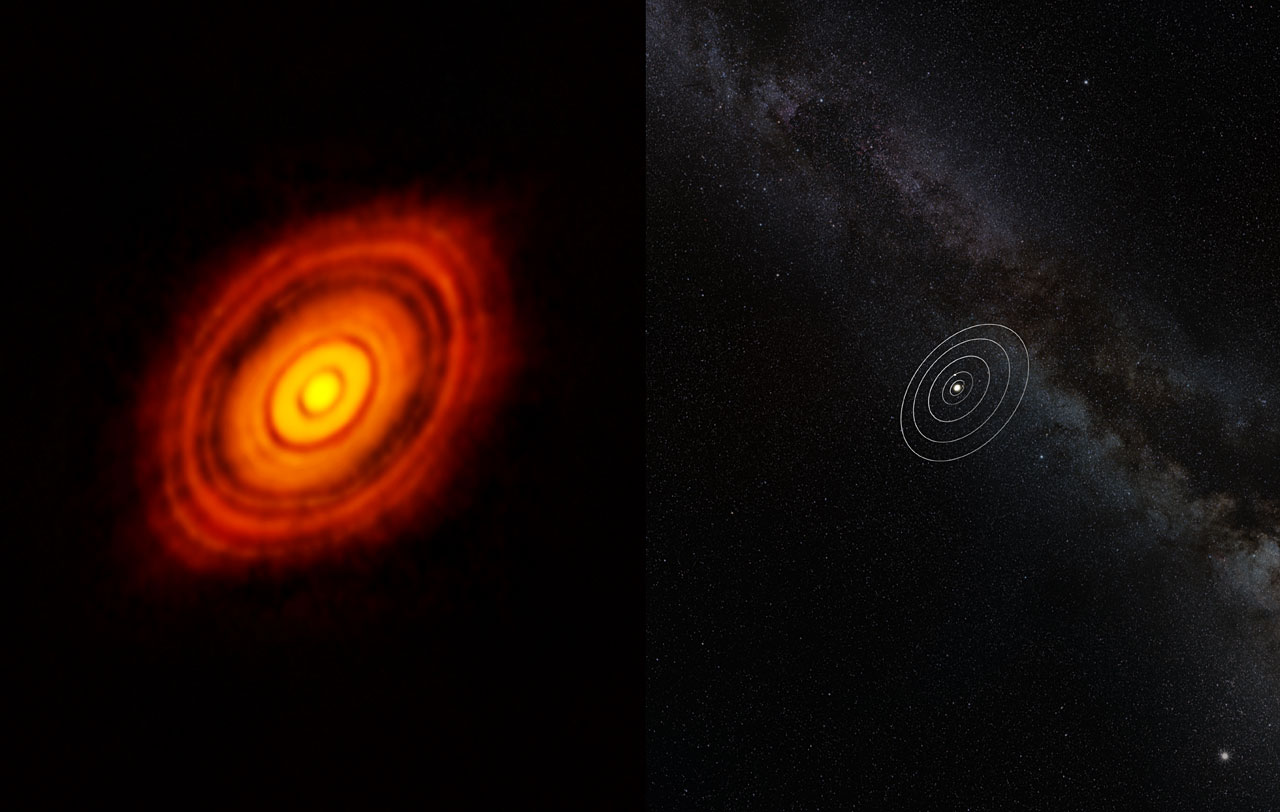As reported by the BBC :
Planet formation
Full Version: Planet formation captured in photo.
Very nice. The ALMA radio telescope is amazing--and will only get better as other antennas are added.
Repeating the observation periodically would be cool, to get a time-lapse movie.
May be the beginning of a new era of exoplanet observation and more, like with the Kepler telescope, great!
May be the beginning of a new era of exoplanet observation and more, like with the Kepler telescope, great!
I suppose that we cannot expect some fast changes in this disc.
After all it's pretty big disc and any significant change can take many years.
Here is comparison with our Solar system from the ESO page.

After all it's pretty big disc and any significant change can take many years.
Here is comparison with our Solar system from the ESO page.

It says in the notes for the text on the ESO page that the resolution is about 5 AU:
[2] The structures are seen with a resolution of just five times the distance from the Sun to the Earth.
How does that mesh with apparent structures being a lot more finely resolved than Jupiter's orbit in the size comparison picture?
[2] The structures are seen with a resolution of just five times the distance from the Sun to the Earth.
How does that mesh with apparent structures being a lot more finely resolved than Jupiter's orbit in the size comparison picture?
Looking at the image that seems about right to me. In fact moving out along a radius there seems to be a semi-regular alternation of dark and bright on about the scale of the radius of Jupiter's orbit. Maybe that periodicity is amplified at the expense of finer structures by the particular geometry of the detector array, but the overall picture looks pretty convincing to me and not inconsistent with the quoted resolution.
Anything in the image that looks finer than that is most likely noise, not signal
Anything in the image that looks finer than that is most likely noise, not signal
Using what I take to be Jupiter's orbit (fourth in from the outside), it looks like 5 AU is about the width of the bands around the star. If the bands themselves are considered the smallest resolved feature, then the scale matches. So perhaps not too much should be made of any perceived details within the bands.
Click to view attachment
Click to view attachment
Rarely can two consecutive posts have made so exactly the same points and in the same order. Centsworth uses less words and provides a great image. Go with centsworth! 
I would just add that the narrowest bright ring about half way out is not well resolved fore and aft but only either side. I think that demonstrates the limit of the image resolution quite well.
I would just add that the narrowest bright ring about half way out is not well resolved fore and aft but only either side. I think that demonstrates the limit of the image resolution quite well.
What is the origin/nature of the electromagnetic data comprising this image? Is the radio array receiving radiant energy emitted by dust lanes, or reflected, millimeter-scale illumination from another source? I'm curious to know just what is producing the "light" within this dark proplyd. The press releases aren't clear on this point, only about how the resolution was achieved.
Here's are my thoughts, along with a quick and crude analysis of the intervals between the gaps:
http://sciencepiazza.blogspot.com/2014/11/hl-tau.html
The worlds sweeping those gaps clean don't appear to be organized according to resonance patterns yet.
http://sciencepiazza.blogspot.com/2014/11/hl-tau.html
The worlds sweeping those gaps clean don't appear to be organized according to resonance patterns yet.
What is the origin/nature of the electromagnetic data comprising this image? Is the radio array receiving radiant energy emitted by dust lanes, or reflected, millimeter-scale illumination from another source? I'm curious to know just what is producing the "light" within this dark proplyd. The press releases aren't clear on this point, only about how the resolution was achieved.
It's thermal radiation by dust around that star. Dust is very cold and it radiates most of energy as electromagnetic waves in far infrared and submillimeter parts of the spectra.
It's thermal radiation by dust around that star. Dust is very cold and it radiates most of energy as electromagnetic waves in far infrared and submillimeter parts of the spectra.
Thank you, machi. This is exactly what I was looking for. I went back to a pre-discovery article and finally found a similar statement:
"To observe unambiguous evidence for collapse, we require high spatial and velocity resolution (to map the velocity field across small structures) and high sensitivity (to take advantage of the spatial and velocity resolution). Furthermore, this must be available at a wavelength at which the collapsing object emits, and at which the surrounding material is transparent."
http://www.almaobservatory.org/en/about-al...lanet-formation
It helps me, at least, to understand that we are seeing dustshine from the colder end of the blackbody spectrum, and that the glow represents dust density, not reflection or excitation from another source, even the core star (our intuitive expectation).
This is a "lo-fi" version of our main content. To view the full version with more information, formatting and images, please click here.
